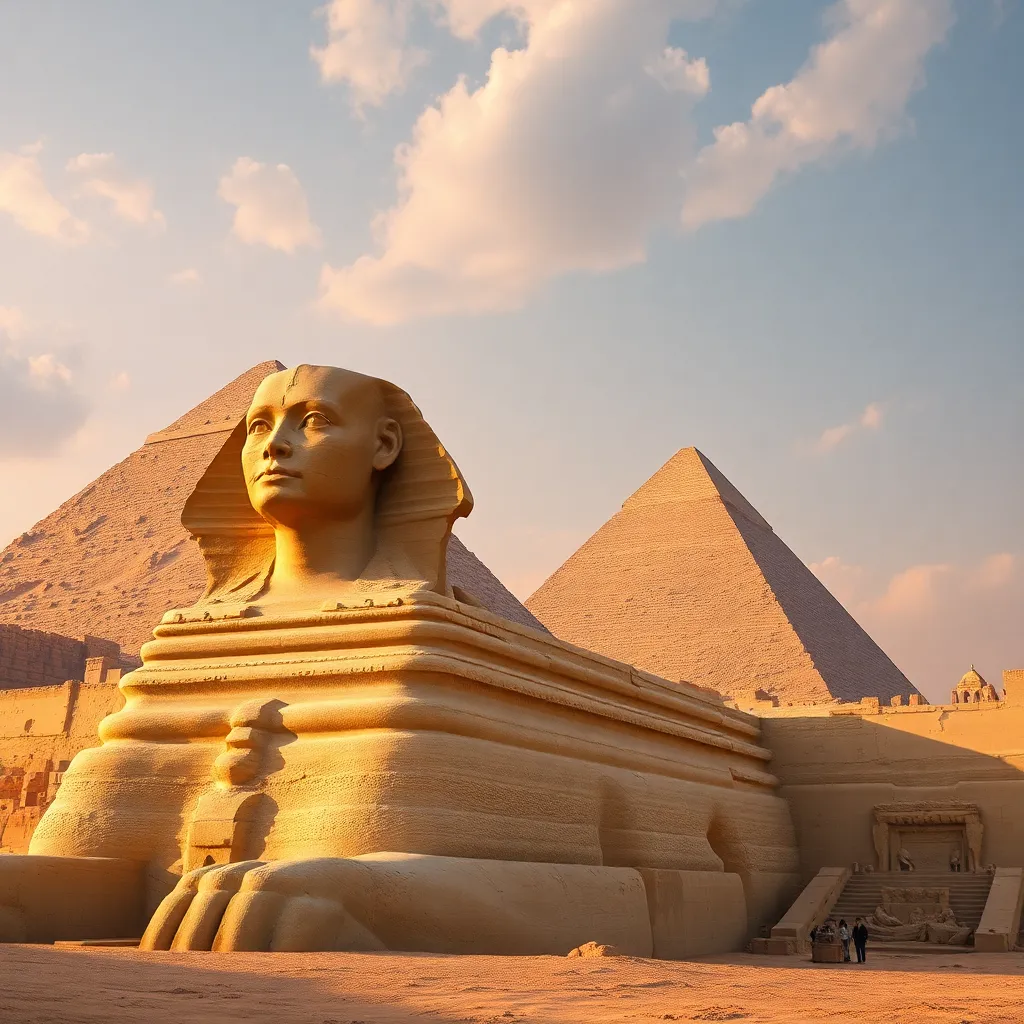The Sphinx: Myths of Adventure and Exploration
I. Introduction
The Great Sphinx of Giza stands as one of the most iconic symbols of Ancient Egypt, embodying the mysteries and grandeur of a bygone civilization. With the body of a lion and the head of a pharaoh, the Sphinx captures the imagination of historians, archaeologists, and adventurers alike. Its historical significance goes beyond mere architectural marvel; it serves as a gateway to the rich tapestry of Egyptian mythology and culture.
Throughout history, the Sphinx has been a focal point in narratives of adventure and exploration, inspiring countless tales of discovery and intrigue. This article aims to delve into the origins, myths, and cultural significance of the Sphinx, exploring its impact on literature, modern tourism, and the ongoing quest for knowledge about this enigmatic monument.
II. The Origins of the Sphinx
The Sphinx has deep roots in the historical and cultural context of Ancient Egypt. Built during the reign of Pharaoh Khafre around 2500 BCE, it is believed to serve as a guardian of the Giza Plateau, watching over the pyramids and the tombs of the pharaohs.
Architecturally, the Sphinx showcases the advanced skills of Egyptian builders. Carved from a single block of limestone, its monumental size—approximately 66 feet tall and 240 feet long—reflects the Egyptians’ sophisticated understanding of art and engineering. The Sphinx’s features also hold significant artistic symbolism, representing strength, wisdom, and protection.
Several theories have emerged regarding its construction and the symbolism it embodies:
- Some scholars propose that the Sphinx was built to honor the sun god Ra, reflecting the pharaoh’s divine connection.
- Others suggest it may serve as a representation of the pharaoh himself, embodying his power and authority.
- Further theories relate the Sphinx to the concept of the afterlife, acting as a protector for the souls of the deceased pharaohs.
III. Myths and Legends Associated with the Sphinx
The Sphinx is steeped in various myths and legends, most notably the Riddle of the Sphinx from Greek mythology. In this tale, the Sphinx terrorizes the city of Thebes, posing a riddle to all who wish to enter:
“What walks on four legs in the morning, two legs at noon, and three legs in the evening?”
Those who cannot answer are devoured by the creature. Oedipus ultimately solves the riddle, leading to the Sphinx’s demise.
Additionally, the Sphinx has a profound connection to the pharaohs and the concept of the afterlife. It symbolizes the transition between the earthly realm and the eternal, guarding the path to the afterlife for the deceased rulers of Egypt.
Across different cultures, interpretations of the Sphinx vary. In some Eastern cultures, it is seen as a symbol of wisdom and knowledge, while in Western narratives, it often embodies the unknown and the challenges faced by explorers.
IV. The Sphinx in Literature and Popular Culture
Throughout the centuries, the Sphinx has captured the imagination of writers and artists, appearing in both classic literature and modern storytelling. Works such as:
- Oedipus Rex by Sophocles
- The Sphinx by Edgar Allan Poe
- The Lost World by Arthur Conan Doyle
depict the Sphinx as a powerful symbol of mystery and enigma.
The Sphinx has significantly influenced adventure tales and exploration narratives, serving as a backdrop for quests and journeys into the unknown. Its iconic status has made it a prevalent symbol in art and media, inspiring everything from films to video games, where it often represents the challenge of facing the unknown.
V. Historical Explorations of the Sphinx
From its discovery to modern archaeological studies, the Sphinx has been a focal point for explorers and archaeologists. Early explorations in the 19th century, led by figures such as:
- Jean-François Champollion, known for deciphering hieroglyphs
- August Mariette, who conducted significant excavations
- Howard Carter, who discovered King Tutankhamun’s tomb
have contributed immensely to our understanding of the Sphinx and its historical context.
These explorations have shed light on the Sphinx’s purpose, its relationship to the surrounding pyramids, and its role within the broader landscape of ancient Egyptian religion and society.
VI. The Sphinx in Contemporary Adventure
In modern times, the Sphinx continues to be a site of fascination and adventure. Recent expeditions have utilized technological advancements such as ground-penetrating radar and 3D imaging to uncover new aspects of the Sphinx and its surroundings.
The Sphinx serves as a major tourist attraction, drawing millions of visitors each year. It plays a vital role in cultural exchange, allowing people from around the world to connect with Egypt’s rich history. Adventure sports and experiences, such as camel rides and guided tours, offer unique ways to engage with this historical site.
VII. The Sphinx as a Catalyst for Exploration
Throughout history, the Sphinx has inspired generations of explorers and adventurers. Its majestic presence has encouraged many to pursue careers in archaeology, history, and cultural studies.
Notable modern explorers influenced by the Sphinx include:
- Dr. Zahi Hawass, an Egyptian archaeologist known for his work on the Giza Plateau
- Dr. Mark Lehner, who has extensively studied ancient Egyptian civilization
The Sphinx represents not just a physical landmark but a symbol of human curiosity and the quest for knowledge, fitting seamlessly into global exploration narratives.
VIII. Conclusion
The Great Sphinx of Giza stands as a lasting legacy of ancient adventure and exploration. Its myths, architectural grandeur, and cultural significance continue to captivate the imagination of people around the world. The ongoing fascination with the Sphinx and its mysteries invites individuals to explore its depths and engage with the rich history it represents.
As we uncover more about this enigmatic monument, we are reminded of the timeless allure of adventure and the enduring spirit of exploration that the Sphinx embodies. Whether through historical study or personal journey, the Sphinx remains a powerful catalyst for discovery.




